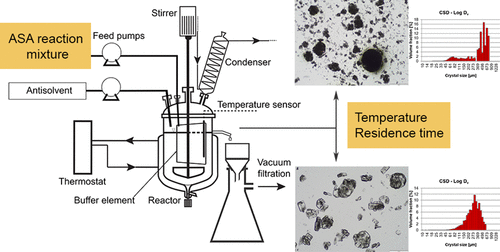当前位置:
X-MOL 学术
›
Cryst. Growth Des.
›
论文详情
Our official English website, www.x-mol.net, welcomes your feedback! (Note: you will need to create a separate account there.)
Direct Processing of a Flow Reaction Mixture Using Continuous Mixed Suspension Mixed Product Removal Crystallizer
Crystal Growth & Design ( IF 3.8 ) Pub Date : 2020-05-21 , DOI: 10.1021/acs.cgd.0c00252 Kornélia Tacsi 1 , Hajnalka Pataki 1 , András Domokos 1 , Brigitta Nagy 1 , István Csontos 1 , Imre Markovits 2 , Ferenc Farkas 2 , Zsombor Kristóf Nagy 1 , György Marosi 1
Crystal Growth & Design ( IF 3.8 ) Pub Date : 2020-05-21 , DOI: 10.1021/acs.cgd.0c00252 Kornélia Tacsi 1 , Hajnalka Pataki 1 , András Domokos 1 , Brigitta Nagy 1 , István Csontos 1 , Imre Markovits 2 , Ferenc Farkas 2 , Zsombor Kristóf Nagy 1 , György Marosi 1
Affiliation

|
Crystallization as the most widespread purification, separation, and morphology-determining method is a critical technology that could be made safer and more economical by using continuous crystallization alternatives. Accordingly, this study aims to develop the continuous crystallization method for direct processing of a flow reaction mixture of acetylsalicylic acid (ASA) and to provide pure, homogeneous crystalline products for further formulation steps. The solid–liquid separation and the purification of the acetylsalicylic acid from the multicomponent mixture were accomplished in a single stage mixed suspension mixed product removal (MSMPR) continuous crystallizer equipped with an overflow and an inner buffer element to ensure the representative withdrawal of the product suspension. The effect of process parameters such as the operating temperature and the length of residence time (RT) on product quality and quantity were studied at two and three levels, respectively. Investigating these parameters, we found that higher operating temperatures (25 °C) and longer residence time (47 min) favor appropriate purity (>99.5%), and narrow crystal size distribution. By reducing the operating temperature (2.5 °C), the yield improved slightly (approximately 77%) and polydisperse products were characterized. The developed crystallization process can link the flow synthesis with the continuous formulation, and consequently serves a further step toward end-to-end production.
中文翻译:

使用连续混合悬浮混合产物去除结晶器直接处理流动反应混合物
结晶作为最广泛的纯化,分离和形态确定方法,是一项关键技术,通过使用连续结晶替代方法,可以使其更安全,更经济。因此,本研究旨在开发用于直接处理乙酰水杨酸(ASA)流动反应混合物的连续结晶方法,并为后续的配制步骤提供纯净,均质的结晶产物。从多组分混合物中固液分离和乙酰水杨酸的纯化是在单级混合悬浮液混合产物去除(MSMPR)连续结晶器中完成的,该连续结晶器配有溢流口和内部缓冲元件,以确保代表性的产物悬浮液排出。分别在两个和三个级别研究了工艺参数(例如工作温度和停留时间(RT))对产品质量和数量的影响。通过研究这些参数,我们发现更高的工作温度(25°C)和更长的停留时间(47分钟)有利于适当的纯度(> 99.5%)和窄的晶体尺寸分布。通过降低操作温度(2.5°C),收率略有提高(约77%),并表征了多分散产物。发达的结晶工艺可以将流式合成与连续配方联系起来,因此可以朝着端到端生产的方向迈进。我们发现较高的工作温度(25°C)和较长的停留时间(47分钟)有利于适当的纯度(> 99.5%)和较窄的晶体尺寸分布。通过降低操作温度(2.5°C),收率略有提高(约77%),并表征了多分散产物。发达的结晶工艺可以将流式合成与连续配方联系起来,因此可以朝着端到端生产的方向迈进。我们发现较高的工作温度(25°C)和较长的停留时间(47分钟)有利于适当的纯度(> 99.5%)和较窄的晶体尺寸分布。通过降低操作温度(2.5°C),收率略有提高(约77%),并表征了多分散产物。发达的结晶工艺可以将流动合成与连续配方联系起来,因此可以朝着端到端生产的方向迈进。
更新日期:2020-07-01
中文翻译:

使用连续混合悬浮混合产物去除结晶器直接处理流动反应混合物
结晶作为最广泛的纯化,分离和形态确定方法,是一项关键技术,通过使用连续结晶替代方法,可以使其更安全,更经济。因此,本研究旨在开发用于直接处理乙酰水杨酸(ASA)流动反应混合物的连续结晶方法,并为后续的配制步骤提供纯净,均质的结晶产物。从多组分混合物中固液分离和乙酰水杨酸的纯化是在单级混合悬浮液混合产物去除(MSMPR)连续结晶器中完成的,该连续结晶器配有溢流口和内部缓冲元件,以确保代表性的产物悬浮液排出。分别在两个和三个级别研究了工艺参数(例如工作温度和停留时间(RT))对产品质量和数量的影响。通过研究这些参数,我们发现更高的工作温度(25°C)和更长的停留时间(47分钟)有利于适当的纯度(> 99.5%)和窄的晶体尺寸分布。通过降低操作温度(2.5°C),收率略有提高(约77%),并表征了多分散产物。发达的结晶工艺可以将流式合成与连续配方联系起来,因此可以朝着端到端生产的方向迈进。我们发现较高的工作温度(25°C)和较长的停留时间(47分钟)有利于适当的纯度(> 99.5%)和较窄的晶体尺寸分布。通过降低操作温度(2.5°C),收率略有提高(约77%),并表征了多分散产物。发达的结晶工艺可以将流式合成与连续配方联系起来,因此可以朝着端到端生产的方向迈进。我们发现较高的工作温度(25°C)和较长的停留时间(47分钟)有利于适当的纯度(> 99.5%)和较窄的晶体尺寸分布。通过降低操作温度(2.5°C),收率略有提高(约77%),并表征了多分散产物。发达的结晶工艺可以将流动合成与连续配方联系起来,因此可以朝着端到端生产的方向迈进。



























 京公网安备 11010802027423号
京公网安备 11010802027423号